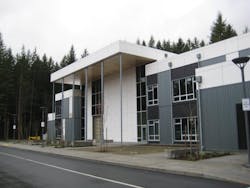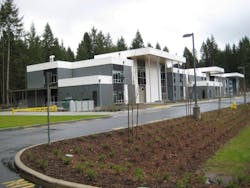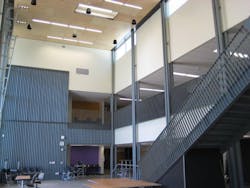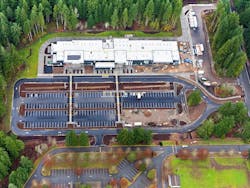Lake Washington STEM school combines modular and site-built construction to meet ambitious schedule
By M SPACE
June 10, 2013
3 min read
When the Lake Washington School District outside Seattle needed a new high school built on an ambitious permitting and construction schedule of seven months, modular construction proved to be an ideal solution.
“Conventional construction just wasn’t an option,” said Allan Long, Sr. Project Manager for M SPACE, the modular contractor for the project.
The LWSD ran into various permitting issues restricting site work on a new Science, Technology, Engineering and Math (STEM) school that was set to open in the fall of 2012. Since the modular process allows the bulk of construction to be done offsite in a factory, with minimal site disruption, the LWSD chose modular as the solution to its challenges.
The school is now serving 300 students, and by 2014, will be at near capacity with 600 9th-12th graders.
Integrus Architects, the designer on the project, began working the modular aspect of the project into it from the beginning, according to Yong Sun Lee, project manager with Integrus.
“In schematic design, we met with and toured various modular manufacturers’ facilities to understand the fabrication process,” Lee said.
“It was in the early stages that we were sensitive to issues of modular dimensions (transportation widths and heights), structure and material types. In design development, we maintained communication with the participating modular manufacturers and dealers with constructability/design insight,” she said.
Blazer Industries in Oregon began building the “mods” in April 2012, and M SPACE started craning them into place in July 2012. The school was constructed in two phases, with the first phase ending in August 2012. M SPACE contracted with Absher Construction as the onsite GC for the civil work, modular construction, roofing, sprinkler system and mechanical, electrical and plumbing.
M SPACE began setting the second phase in September 2012 and finished the following month, with the remaining site work completed by March 2013. With the two phases combined, the permanent 65,000 square-foot two-story school has 24 classrooms, a presentation hall, common areas, administrative offices and a nurse’s office. Additional features include photovoltaic panels in part of the roof, storefront windows, power cord reels in the science studios, two-hour rated walls, and light dimming ballasts in fixtures.
Four spaces in the school were site built, allowing modular and traditional construction to be combined to best suit the client’s need. The site-built commons has 22-foot ceilings, offering an open and inviting space for students. The top of the commons – the roof mods – were built in the factory, reducing the amount of time that workers had to spend at significant heights, according to Alan Duer, M SPACE Pacific Northwest Territory Manager.
“Mixing modular construction with conventional construction proved to be a valid alternative to the old ways of building,” Duer said.
To learn more about the school, please visit the M SPACE website.
Sign up for Building Design+Construction Newsletters




